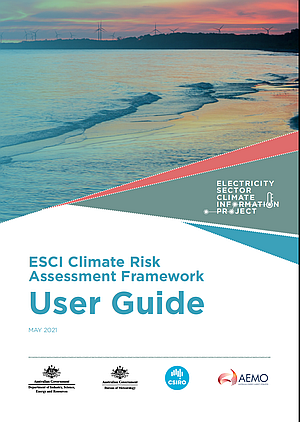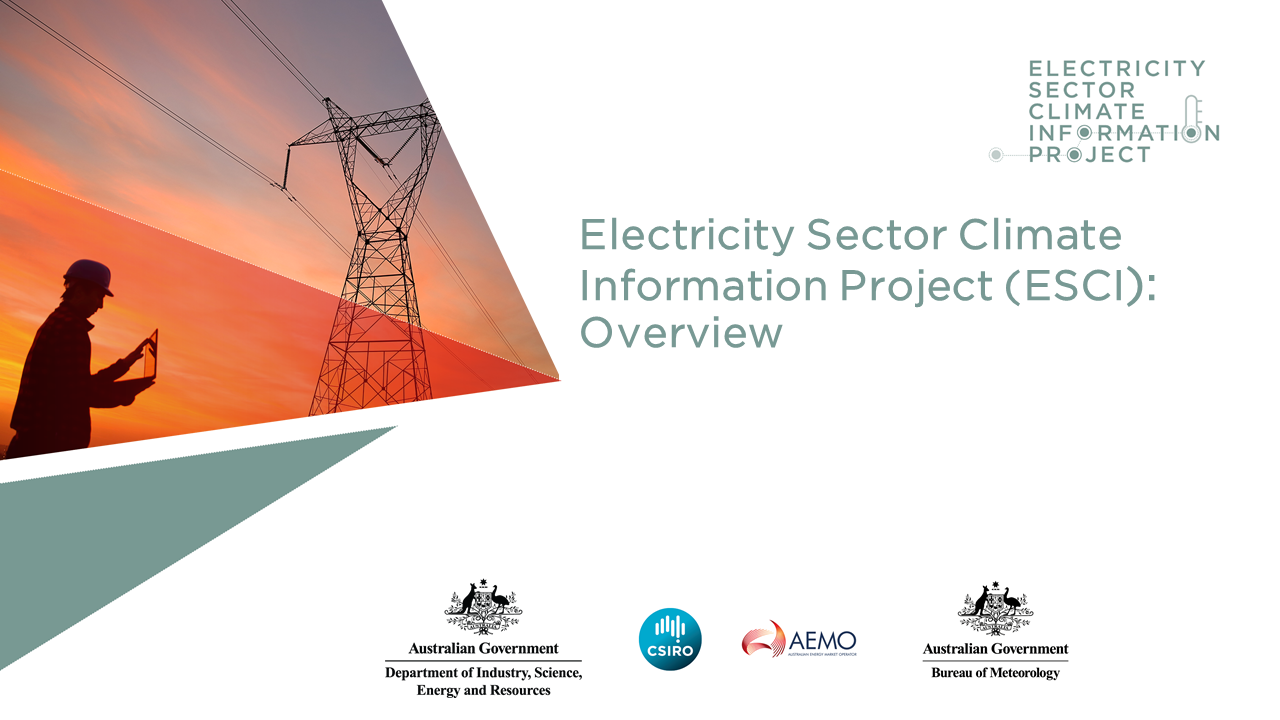Climate Change in Australia
Climate information, projections, tools and data
ESCI Additional Resources
- ESCI User Guidance
- ESCI PowerPoint Presentations
- ESCI Conference Presentations
- ESCI Project Figures & Images
ESCI User Guidance
Publications / Additional Resources
ESCI User Guide
This is a step-by-step guide to using the ESCI Climate Risk Assessment Framework and choosing and using appropriate climate data. The User Guidance is provided online and as individual chapters for download. It is also available here as a single download for your convenience. Individual sections are available for download from their respective pages in the User Guidance section of the website
ESCI PowerPoint Presentations
Publications / PowerPoint Presentation
Electricity Sector Climate Information Project (ESCI): Overview
The science of climate change is the foundation of a climate risk assessment but is a complex and sometimes polarising topic. The ESCI project has created a straightforward presentation on climate change to provide background information for a discussion of climate risk. This can be adapted to your needs and used with internal and external stakeholders such as senior executives and board members.
ESCI Conference Presentations
Publications / Conference Presentations
Future projections of convective environments related to severe wind gusts
Thunderstorms can produce severe convective winds (SCWs) that damage buildings and other infrastructure such as electricity transmission towers. Understanding the climatology of SCWs is therefore important for planning and risk management. Due to the lack of long-term, spatially consistent SCW observations and limitations of climate model simulations of severe thunderstorms, we calculate a range of commonly used environmental diagnostics from the ERA5 reanalysis and assess their ability to identify observed SCWs in Australia. A range of diagnostics found to skilfully identify SCW events are then applied to 12 global climate models (GCMs) from the fifth Coupled Model Intercomparison Project (CMIP5) in order to examine projected future changes to SCW environments. Future projections of SCWs are sensitive to the method used, as diagnostics based on convective available potential energy (CAPE) generally project more SCW environments in the future associated with increasing concentrations of low-level atmospheric moisture, while some other diagnostics project fewer events associated with decreasing mid-level lapse rates. Results are also shown for an experimental diagnostic based on the regression of multiple environmental variables on to the observed SCW data, intended to represent multiple types of convective environments for improved representation and understanding of SCW climatology.
View on Publisher's WebsitePublications / Conference Presentations
Practical applications of the Bureau of Meteorology Atmospheric Regional Projections for Australia
Australia’s climate has large inter-annual variability and has experienced extreme weather events in the past. With many extreme events expected to become more pronounced with climate change there is a heightened need for robust fine-scale projections of future changes in extremes. The Bureau of Meteorology (Bureau) is working towards the development of ‘seamless’ modelling that would underpin seamless services for hazards across both weather and climate timescales, from the historical past through to the present, and from reanalyses through nowcasting, weather and seasonal predictions to future climate change projections. We present a range of post-processed data products (with calibration methods applied) obtained from dynamically downscaled regional climate projections based on the Bureau of Meteorology Atmospheric Regional Projections for Australia (BARPA). Practical applications are discussed, including with a focus on energy sector planning purposes. Example BARPA projections are presented for future changes in extremes, such as temperatures above 50°C, as well as values corresponding to 10-year average recurrence interval (ARI). This project is co-funded by the Australian Government Department of Industry, Science, Energy and Resources through the Electricity Sector Climate Information (ESCI) Project.
View on Publisher's WebsiteESCI Project Figures & Images
Images which have been used in the project materials and that belong to the project are provided here for download. Please attribute to the ESCI project.
DownloadUser Guide - All images (zip 4.1 MB)





